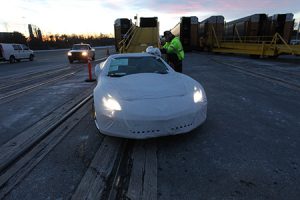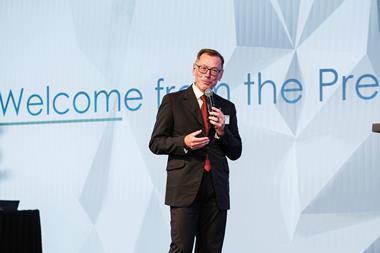 Will bitcoin prove to be one of the most valuable innovations in changing the finished vehicle supply chain? If so, it is not because carmakers and logistics providers are moving their contracts from dollars, euros or yuan to the virtual currency (although given its recent escalation in value, some may wish they had). Instead, it will be because the technology that underpins transactions and information for bitcoin, known as ‘blockchain’, may be able to help bridge historic gaps in visibility that have long been associated with moving vehicles through complex supply chains.
Will bitcoin prove to be one of the most valuable innovations in changing the finished vehicle supply chain? If so, it is not because carmakers and logistics providers are moving their contracts from dollars, euros or yuan to the virtual currency (although given its recent escalation in value, some may wish they had). Instead, it will be because the technology that underpins transactions and information for bitcoin, known as ‘blockchain’, may be able to help bridge historic gaps in visibility that have long been associated with moving vehicles through complex supply chains.
However, despite a lot of recent buzz around this technology, many in the vehicle logistics sector are still blissfully unaware of its widespread potential.
When multiple participants in a supply chain transact, each party typically maintains their own record of the goods transferred, increasing the complexity and costs of record keeping. But the details recorded by one company in its system may differ to those recorded by others, giving rise to disputes that can be costly and time-consuming to resolve.
[in_this_story align="right" border="yes"]For vehicle logistics, such gaps are particularly evident in the multi-stage, multimodal delivery process, including transfer points between assembly lines and yards, from yards to trucking carriers, truck to rail, rail to processor, processor to shipping line, and so on. There is considerable room for information to fall through the cracks, especially across different internal IT systems.
To try and overcome this, an increasing number of logistics companies and customers are considering implementing blockchain technology.
A blockchain is essentially a digital ledger of transactions that can be used to gather data from multiple sources whenever asset exchanges take place. Once added to the ledger, such data cannot be modified or removed by anyone, only appended with new information to clarify or correct improperly entered information. All the data collected can also be shared across authorised sources.
“Blockchain is a distributed ledger technology that creates a permanent transaction record which can be shared with different parties in a business network,” says Ben Stanley, automotive research lead at the Institute for Business Value at IBM Global Services. “The transaction record will typically hold information about an asset exchange between different parties or a status update to a specific asset.”
By handling transactions this way, he says, blockchain technology enables different parties to transact directly with each other and distributes control so that no one party dominates – meanwhile, the shared ledger becomes a single system of record that all parties in the network can reference as their ‘source of truth’ about transactions. That is why it is so effective as an underlying system for a virtual currency like bitcoin and why it may work well for logistics.
“Blockchain enables greater transparency of information, increased trust and reduced friction between parties doing business,” adds Stanley. “It also has the potential to lower settlement periods required to fulfil contracts between parties and to free up working capital so that it can be re-deployed for other endeavours.
 "Blockchain enables greater transparency of information, increased trust and reduced friction between parties doing business. It also has the potential to lower settlement periods required to fulfil contracts between parties and to free up working capital." - Ben Stanley, IBM Global Services
"Blockchain enables greater transparency of information, increased trust and reduced friction between parties doing business. It also has the potential to lower settlement periods required to fulfil contracts between parties and to free up working capital." - Ben Stanley, IBM Global Services
“With blockchain, distributed ledgers can be shared and updated in near-real time across the participants in the supply chain. Every transaction becomes part of the permanent record and can be scrutinised by those that have permission, and relevant information can be shared,” he adds.
Stanley believes blockchains will “shift the paradigm” from information being held by a single owner to a shared lifetime history being created for an asset or transaction. Instead of messaging-based communications, such communications would be ‘state-based’ – meaning information that was once obscure will be visible.
[sta_anchor id="1"]“Blockchain is similar to a database,” notes Matthias Berlit, vice-president of manufacturing logistics at German software specialist Inform, “but it is much more secure because it is distributed with hundreds of copies on all nodes of the network and because each transaction is validated by the nodes – and a transaction is confirmed only if all agree.”
Application potentialA number of organisations are now actively exploring the range of possible applications for blockchain across the logistics sector, including IBM, Finland-based Kouvola Innovation (via the EU-backed SmartLog project), Marine Transport International (with its COMSHIP software) and Australian blockchain solutions provider Blockfreight.
According to Julian Smith, founder and chief executive of Blockfreight, the current uses of the technology in vehicle logistics chains mainly relate to compliance, auditing and reporting.
Shay Sidner, director of operations at software solutions provider flexis North America, says there are many uses for blockchain technology but points out that because the technology is still developing, it is yet to be determined how effective it would be in large supply chains.
“As for finished vehicle logistics, the opportunity resides in efficiency of transactions and document exchange,” she says. “This could lead to faster exchanges of ownership and document verification, allowing for a reduction in the overall end-to-end delivery and payment process. This could open the doors of opportunity for more shared distribution channels within the finished vehicle logistics network.”

Stanley believes blockchain technology could prove particularly useful for distribution staff at carmakers, who need to coordinate with multiple participants in the finished vehicle value chain, including third-party logistics, rail, shipping and trucking companies, as well as customs agencies, to ensure the timely delivery of new vehicles around the world.
Here, he says, a blockchain-based system would provide authorised participants in the chain with an accurate, timely and transparent end-to-end view of information such as vehicle movement and condition.
[sta_anchor id="2"]“This type of information would be available to all, while other sensitive information [for example, relating to terms and conditions or pricing] would only be accessed by participants needing to complete their particular transaction, thus providing privacy of information to others,” he says.“Benefits of this include improving just-in-time logistics, reducing erroneous orders and lost or damaged vehicles, while providing better forecasting and reducing lead times among all participants.”
Smart contractsInform has recently embarked on what Berlit describes as an “experimental” blockchain implementation based on a simple freight exchange system that brings manufacturers and carriers together in the transport process and leads to carriers getting paid automatically after carrying out a transport job.
The experiment helped the company learn about current private, public and consortium blockchain projects – such as blockchain app platform Ethereum and open-source collaboration Hyperledger – and deepen its understanding of how blockchains work in existing environments.
According to Berlit, the experiment also enabled staff to consider how so-called ‘smart contracts’ – programmed contracts in which meeting certain contractual rules automatically triggers payments, for example when a delivery is completed – could work alongside blockchain systems.
“We were surprised how straightforward the implementation of a blockchain and smart contract system is. In my view, the most promising application area in finished vehicle logistics is still the VIN ledger,” he says.
Such blockchain-enabled VIN ledgers could store a variety of relevant information about a VIN and feature a digital key system granting access to some or all of this information to the right partners in the supply chain.
“If every position update, damage and hold could be stored for everybody in that chain, the need to connect the hundreds of IT systems directly to each other would be obsolete,” Berlit comments.
Jon Kuiper, chief executive at Netherlands-based vehicle logistics provider Koopman Logistics, also expects future applications to be about VIN-based information flows.
[mpu_ad]“You can think of track-and-trace of vehicles through the chain, but also the capturing of electronic CMR data,” he says, referring to official transport documents. “By using smart contracts and automatic ownership changes, invoicing and many other activities can be triggered.”
The key advantages of such an approach, he believes, would be end-to-end visibility of the VIN in the supply chain and the ability to capture all relevant historical VIN data in one information ledger – including details relating to track-and-trace, damages and repairs that, he says, “could fundamentally reduce transactional costs in the integral supply chain”.
[sta_anchor id="3"]“A key challenge is to implement this blockchain-based infrastructure in an environment that is currently working on a myriad of connected or unconnected IT systems. I think finished vehicle suppliers should work with trusted IT partners to seize this opportunity to the advantage of the industry,” he suggests.
Visibility benefitsFinnish industry expert, Mika Lammi, head of IoT business development at Kouvola Innovation – who is currently coordinating the SmartLog project aimed at spearheading blockchain implementation in the logistics industry – singles out the creation of “total supply chain visibility scenarios” as another immediate-use case for blockchain. He thinks such visibility could easily be achieved by enhancing the sharing of information using advanced automation technology within smart contracts.
Christian Schwede, head of the Information Logistics and Decision Support Systems Department at Fraunhofer IML, agrees that the tracing of vehicles via blockchain is so far the most valuable opportunity for outbound logistics, but he also anticipates other applications. Schwede is currently working on the Smart Objects and Smart Finance (SOFiA) project to apply the technology to autonomous containers in logistics networks, for example.
He predicts blockchain systems could become the basis for smart digital process management across entire supply chains, particularly as they could connect the financial, information and physical flows of all the partners in the network and enable the digitisation of business rules relating to smart contracts, such as ordering, extra transport, transactions, invoicing, goods receipts and customs declarations.
 Blockchain-enabled VIN ledgers could store details of a vehicle's track-and-trace data, as well as damages and repairs
Blockchain-enabled VIN ledgers could store details of a vehicle's track-and-trace data, as well as damages and repairs“To manage operative finished vehicle logistics in the future, the local IT systems of each partner will be connected via blockchain to ensure trust-based, evaluated and digital process management. The whole operative outbound process can be managed digitally based on blockchain,” he says.
For Sidner at flexis, the clear advantage of using blockchain technology is the ability to share data within a network across various providers, in the process creating a ledger of activities that can easily be followed by the source system provider or those given controlled secure access.
“The sharing of information across different entities becomes easier as fully integrated solutions are not required. With the blockchain technology, secured data can flow more seamlessly, allowing for faster processing and more direct communication channels,” she adds.
Stanley, meanwhile, singles out the fact that transactions can be conducted in near-real time as a key benefit. He also points to the abilities of blockchain systems to save costs by eliminating intermediaries in the value chain, as well as their power to mitigate risks by making transactions verifiable and auditable.
“Blockchain also opens new business models. Logistics value chains can be reshaped and potential new profit pools identified,” he says. “The key advantages would have to do with the implications of far superior quantity and quality of operational information that can be shared with a significantly lower barrier to entry than ever before,” adds Kouvola’s Mika Lammi.
Limited proofPhilipp Sprenger, research associate at the Department of Procurement & Finance in Supply Chain Management at Fraunhofer IML, agrees that a combination of the lean and trusted, secure approach of blockchain and its function as a consistent shared database is a key potential benefit for stakeholders in the vehicle logistics sector.
However, Sprenger still warns companies interested in this technology that proofs of concept in business environments remain limited. “Right now, there are some research pilots in several logistics-use cases, but none in finished vehicle logistics that we know. Community and a broad base of knowledge is also missing in the industry,” he says.
Matthias Berlit, meanwhile, points out that the challenges of implementation are in many ways similar to the typical challenges faced in implementing any new systems, especially in traditional industries like automotive where each carmaker and logistics provider has legacy systems that cost a lot to change. As a result, he suggests, cooperation will be the key to moving towards larger systems.
For Lammi, the main remaining challenges have more to do with control of access to the information held in blockchain systems and the “raw data ownership change implications” involved. In his opinion, these challenges can only be overcome by “diligent work on the sharing platform foundations” and a focus on making sure that “every stakeholder’s interest is balanced”.
 Some believe blockchain systems could become the basis for smart digital process management across entire supply chains
Some believe blockchain systems could become the basis for smart digital process management across entire supply chainsSidner suggests the key challenges relate to the technology’s current ability to handle such large volumes of complex data and to how it can be used in a [sta_anchor id="4"]collaborative way across outbound vehicle logistics networks. “Finding a common standardised data structure across all entities within the outbound supply chain, will be challenging. As experts in the industry work to understand the capabilities of the technology and viable use cases, I am certain technology and solution providers will work together and collaborate with customers to overcome gaps in the capabilities of the solution based on the overall requirements,” she says.
Future stepsIn the near future, Berlit argues that a central VIN ledger could resolve a wide range of issues currently experienced in setting up interfaces between partners in the supply chain. Thinking further ahead, he also suggests such ledgers could contain information about the parts built into the car.
“Following handover to the customer, they could contain a digital key to the car in order to connect with a ‘car app’. When the car receives its regular inspections in later years, service centres could add the information into the VIN ledger so that all the relevant [service history] information is contained on it when selling the used car again,” he explains.
Although Sidner believes it is difficult to predict what the key trends in blockchain technology will be over the next few years, she is confident that use of the technology will help increase the efficiency of transactions, as well as transparency and visibility throughout outbound supply chains.
“I really think the future will depend on whether or not the industry embraces the technology and trusts in the idea of a virtual data world. If so, there could be great benefit in making the logistics flow more efficient,” she says.
Lammi agrees it is hard to predict what direction blockchain implementation in logistics will eventually take – at least until the technology “reaches milestones in areas of governance models, standardisation and cross-operationality”.
Jon Kuiper from Koopman believes the future of breakthrough blockchain applications in finished vehicle logistics is “in the hands of the suppliers” because they are uniquely positioned to provide solutions that can be used for multiple OEM customers. “I do believe we will see the first applications being brought to the market this year,” he adds.
[related_topics align="right" border="yes"]Stanley points out that finished vehicles could themselves have an important role to play in a blockchain-based world, using on-board digital technology capable of connecting with the ‘internet of things’ to report on their location, any damage experienced or mechanical problems. As such technologies become available, he says, vehicles knowing their destination could also prevent handling or routing mistakes and even optimise their logistics movement for future vehicles.
“This will enable the car to actually be a peer in the blockchain network and to transact with each of the other participants throughout the distribution process,” he predicts.
It may yet be a little while off, but the potential for blockchain, it seems, is most definitely out there – and coming soon to a finished vehicle supply chain near you.
 "Blockchain is similar to a database but it is much more secure because it is distributed with hundreds of copies on all nodes of the network and because each transaction is validated by the nodes – and a transaction is confirmed only if all agree." - Matthias Berlit, Inform
"Blockchain is similar to a database but it is much more secure because it is distributed with hundreds of copies on all nodes of the network and because each transaction is validated by the nodes – and a transaction is confirmed only if all agree." - Matthias Berlit, Inform





































